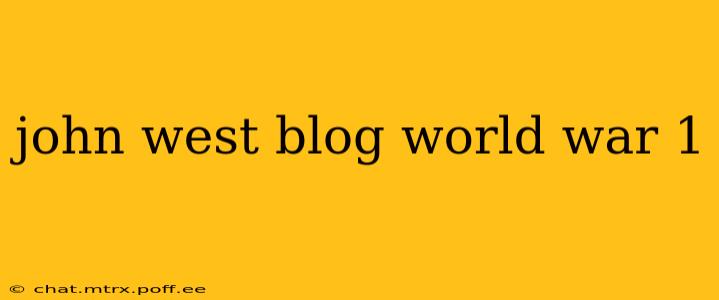The First World War, a conflict that reshaped the geopolitical landscape, continues to fascinate and horrify in equal measure. While countless books and documentaries explore the grand strategy and major battles, the individual experiences of those caught in the maelstrom often remain obscured. This blog aims to delve into the personal stories, lesser-known aspects, and societal impacts of WWI, particularly through the lens of how it might relate to a hypothetical "John West" – a fictional character representing the average soldier or civilian whose story might otherwise be lost to history. We will use John West as a touchstone to explore broader themes and answer frequently asked questions about the war.
What Was the Main Cause of World War I?
World War I, also known as the Great War, erupted due to a complex interplay of long-term tensions and immediate triggers. While the assassination of Archduke Franz Ferdinand of Austria-Hungary served as the spark, the tinderbox had been accumulating for years. Nationalism, imperial rivalries, militarism, and a tangled web of alliances all contributed to a climate ripe for conflict. Imagine our fictional John West, a young man swept up in the wave of patriotic fervor, perhaps unaware of the complex political machinations that propelled his nation into war. His experience, while personal, reflects the collective impact of these larger forces. The failure of diplomacy to resolve escalating tensions is a crucial element often overlooked, but it was the crucial failure that allowed the conflict to escalate.
What Were the Main Battles of World War I?
The war saw a series of brutal and protracted battles, many of which resulted in staggering casualties. The Western Front, characterized by trench warfare, witnessed some of the most iconic and devastating battles, including the Battles of the Marne, Verdun, and the Somme. These battles, involving millions of soldiers, exemplified the horrific realities of modern warfare. Our hypothetical John West might have participated in one or more of these battles, experiencing the relentless shelling, the claustrophobia of the trenches, and the constant threat of death. Understanding these key battles helps us contextualize the sheer scale of the conflict and its human cost. Beyond the Western Front, battles like Gallipoli and those on the Eastern Front also played crucial roles in shaping the war's outcome.
How Did World War I Affect the Civilians?
The impact of World War I extended far beyond the battlefields. Civilians faced rationing, economic hardship, and the constant fear of air raids and attacks. Women were increasingly vital to maintaining the home front, taking on jobs previously held by men. Propaganda played a significant role in shaping public opinion and mobilizing support for the war. For a civilian John West, the war might have meant working long hours in a factory, enduring food shortages, or living under the constant stress of uncertainty. His experiences, and those of his family and community, would paint a picture of the profound disruptions affecting the home front, a critical element often overlooked in discussions about military operations.
What Were the Long-Term Effects of World War I?
World War I's consequences were far-reaching and long-lasting. The war led to the collapse of empires, the redrawing of national boundaries, and the rise of new ideologies. The Treaty of Versailles, aimed at establishing lasting peace, instead sowed the seeds of future conflicts. The immense human cost of the war left a generation scarred, both physically and psychologically. For our John West, surviving the war wouldn't necessarily mean an immediate return to normalcy. He might face physical and mental scars, economic hardship, and the challenges of reintegrating into a society fundamentally changed by the conflict. This lingering impact on individuals and nations is a key aspect in understanding the war’s true legacy.
What New Technologies Were Used in World War I?
World War I witnessed the devastating introduction of new technologies of warfare. Machine guns, poison gas, tanks, and airplanes transformed the battlefield, leading to unprecedented levels of destruction and casualties. Imagine John West encountering these innovations firsthand – the terrifying roar of machine guns, the suffocating clouds of poison gas, or the terrifying sight of tanks rumbling across No Man's Land. Understanding these technological advancements is essential to fully grasping the war's brutal and transformative nature.
This blog will continue to explore the World War I experience through various perspectives, always returning to our fictional John West to highlight the human dimension of this pivotal moment in history. By examining individual stories alongside the broader historical context, we can develop a richer, more nuanced understanding of this defining event.
